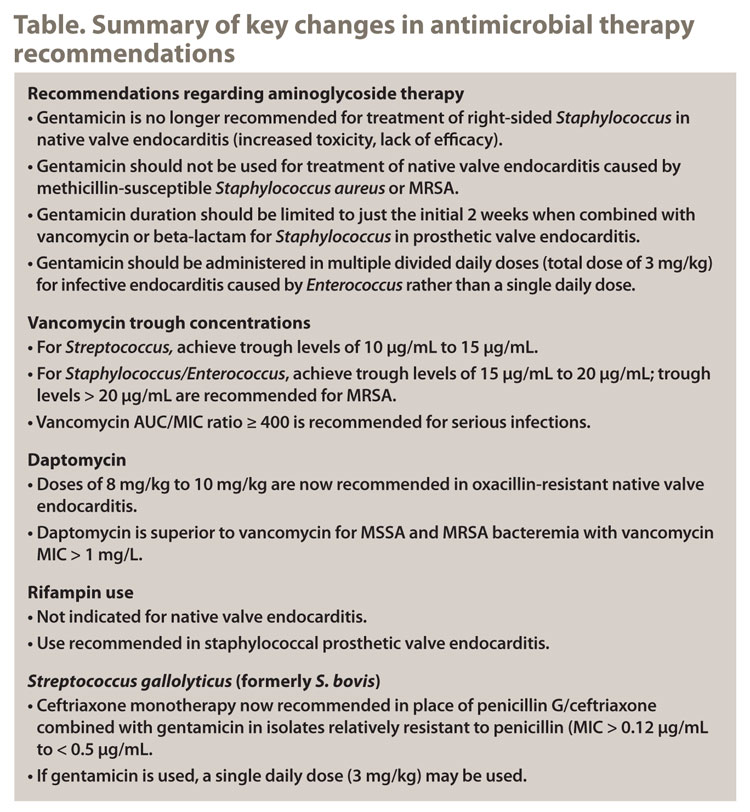A look at the new infective endocarditis guidelines
Infective endocarditis is an infection of the endocardial surface of the heart involving at least one heart valve. Treatment guidelines from both the American Heart Association, endorsed by the Infectious Diseases Society of America, and the European Society of Cardiology have been updated.
The overall incidence of infective endocarditis has been increasing in the United States secondary to a shift in the characteristics of the patient populations with infective endocarditis, which reflects increased average age, IV drug use and an increased proportion of patients with intracardiac devices or prosthetic valves. In addition, the epidemiology of causative organisms has changed and Staphylococcus aureus is now the most common organism causing infective endocarditis. Unfortunately, higher incidence rates of S. aureus may lead to higher mortality rates, increased length of hospital stay and higher costs compared with other organisms. The incidence of infective endocarditis caused by viridans group streptococci has continued to decline, possibly due to overall improved dental hygiene and care.
The Duke criteria and echocardiography are still the primary tools used in diagnosing infective endocarditis. New imaging techniques such as 3-D echocardiography, head-to-toe multislice CT, and cardiac MRI have emerged as diagnostic options. The 2015 guidelines make an additional recommendation to obtain at least three sets of blood cultures from different venipuncture sites, with the first and third samples being drawn at least an hour apart. Repeat echocardiography is now recommended in 3 to 5 days or sooner (compared with the 2005 recommendation of 7 to 10 days) if there is high suspicion of infective endocarditis despite a negative initial transesophageal echocardiogram or if clinical findings change.


Early surgery is indicated in prosthetic and native valves for patients who have symptoms and signs of HF, fungal infections, persistent infections as defined by the guidelines, and when infective endocarditis is complicated by heart block, annular or aortic abscess, or destructive penetrating lesions.
ESC has recommended the creation of multidisciplinary infective endocarditis teams; however, the AHA guidelines simply state that patients with infective endocarditis generally require management by a team of physicians and allied health providers. Per the AHA guidelines, teams should be used to help determine whether surgery is indicated and when to perform it. AHA also recommends using teams for treatment of Enterococcus that is resistant to penicillin, aminoglycosides or vancomycin. We feel that a team approach to management of infective endocarditis with integration of pharmacists to help manage/monitor antimicrobial therapy (especially aminoglycosides) and infectious disease consultation would be helpful in managing patients with infective endocarditis.
Many recommendations concerning antimicrobial therapy have been updated and are listed in Table 1.
Anticoagulation was briefly discussed by the 2015 guidelines. Overall, initiation of antiplatelet agents (including aspirin) is not recommended in infective endocarditis. Discontinuing anticoagulation is controversial, and the guidelines suggest discontinuation of anticoagulation for at least 2 weeks in patients with mechanical valve infective endocarditis that had a central nervous system embolic event. However, continuation of long-term antiplatelet therapy at the time of development of infective endocarditis with no bleeding complications may be considered.

Sources: Baddour LM, et al. Circulation. 2015;doi:10.1161/CIR.0000000000000296 and Habib A, et al. Eur Heart J. 2015;doi:10.1093/eurheartj/ehv319.
Dental management of patients with infective endocarditis is a notable concern. The guidelines did not discuss prophylactic antibiotic use for dental procedures in patients at high risk for developing infective endocarditis. However, there was a recommendation to have inpatients with infective endocarditis evaluated by a dentist to identify and eliminate oral conditions that could contribute to recurrent infective endocarditis, and patients should be educated on the importance of proper oral hygiene. It is noted that poor oral hygiene and periodontal disease, not dental office procedures, are likely to be responsible for most cases of infective endocarditis that originate from the mouth.
The updated guidelines emphasize the changing epidemiology of organisms responsible for infective endocarditis, new diagnostic tools and several modified antimicrobial treatment recommendations.
- References:
- Baddour LM, et al. Circulation. 2015;doi:10.1161/CIR.0000000000000296.
- Habib A, et al. Eur Heart J. 2015;doi:10.1093/eurheartj/ehv319.
- For more information:
- Kaylie Gabur, PharmD candidate, is from the South Dakota State University College of Pharmacy. Tadd Hellwig, PharmD, BCPS, is an associate professor of pharmacy practice at the South Dakota State University College of Pharmacy. Sarah A. Spinler, PharmD, FCCP, FAHA, FASHP, AACC, BCPS (AQ Cardiology), is professor of clinical pharmacy and the residency and industry fellowship programs coordinator at Philadelphia College of Pharmacy at the University of the Sciences in Philadelphia. Spinler is the Cardiology Today Pharmacology Consult column editor. She can be reached at Philadelphia College of Pharmacy at University of the Sciences, 600 N. 43rd St., Philadelphia, PA 19104; email: s.spinle@usciences.edu.
Disclosure: The authors report no relevant financial disclosures.









